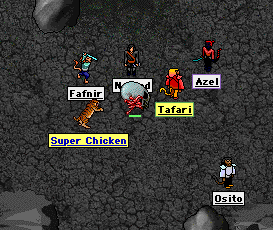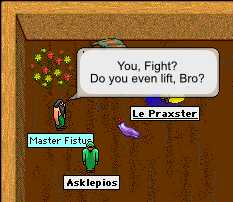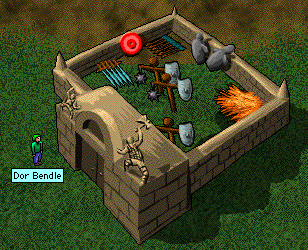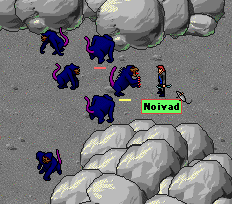Fighting
Quick Links to CLUMP Content
10 Things for Newbies | Basic Game Mechanics | Creatures | Fighting | Group Hunting | Healing | Mystics | Macros | Tactics | Index | Links

There's more to fighting than simply running up to a creature and swinging wildly until you or it is dead. This section covers everything from weapons, trainers to special movement styles.
What you will learn in this part: fundamental concepts of fighting, trainers that relate to fighters, weapons, survival, finding your own style and developing it, finding your limits, all about monsters and other beasts you will encounter and a few places where you can learn these things on your own.
Reading alone is not enough to make you a great fighter, it takes practice and dedication to improve yourself, along with a healthy dose of varied terrain and combat experience.
Fighting Basics
A seminal work on learning how to fight is Nohn's Better Living Through Fast Feet. It's more of a tutorial, and does a great job at teaching the fundamentals of fighting. If you're new to CL and haven't read it please do. In case you're still not convinced, it presents some of the information here in a much more friendly and accessible way. Summing it up in 2 sentences: bump into a creature to swing at it. Then run away from it while you regain your balance.
In Clan Lord if you're holding a weapon in your right hand (the only hand weapons will equip to), when you bump into a creature you will take a swing at it. If you keep bumping into it, then you will keep swinging at it. Your balance is indicated by the second bar. The Balance Section on this page deals more with the importance of having balance.
The most basic rule of fighting is don't fight on red. If your health gets low your name plate turns yellow or red (the first bar turns yellow or red) run away. If there are healthy fighters that you know can take on the creature that almost killed you, run past the fighter and behind them, and usually the creature chasing you will go after that fighter. If it keeps chasing you and ignores the fighter (or rod), keep running behind them until the creature focuses on them. If you know a hit from a creature will kill you, don't chance it, run—especially if you are alone.
If you have to run and there are many creatures in your path, un-equip your purse so that you won't stop and swing on creatures you accidentally bump in. Use Terrain to gain a little distance from the creatures if you need to.
Tip/Opinion: If you find yourself fatigued by constantly holding down the mouse button to move, it's a good idea to go into the Clan Lord Preferences and switch your movement to click toggles. Also, it prevents you from accidentally stopping at the wrong moment. But you have to remember to stop running in a direction when you fall or when you are raised you'll go running off, sometimes towards a creature and end up falling again.
Tip: If you get surrounded and you know you are going to fall, quickly sunstone your location, (i.e. "SF," or even better if you have the time. "Falling SF. Scout Column." The more precise you are the faster you can get rescued, but in most cases just the general area is enough, because some regions have few snells. If you do fall without sunstoning your location, toggle a person and share with a mystic if one is on. Some mystics can locate people with pinpoint accuracy.
Tip: The faster you run at a creature the farther your reach. If you stay far enough away it will target the closer person, that way you don't draw the attention of the creature away from the brick.
Balance
As you've noticed, with each swing you take, you lose balance temporarily (the center bar in the upper left hand corner). The lower your balance, the easier you are to hit. This is also true for creatures. So, the best way to fight something, is to make it swing first, then immediately swing on it and run away to regain balance for another swing. If it is something you can brick after one swing, you can stand there until your balance comes back and hit it again. If it is something you don't brick, instead of standing there swinging out, it is wisest to fall back out of reach of the creature until your balance has returned to full.
On a side note: this principle of balance and facing, and being able to directly influence how much you have and how fast you regain balance is what sets Clan Lord apart from most online games I've seen.
Facing
Because facing is a more recent addition to Clan Lord, and most scrolls were written before this feature was added and never updated, many scrolls neglect to mention this, and until now such information has been passed on orally. The direction something is facing matters for both you and other creatures. It is hardest to hit something from the front, and easiest to hit something from the back. As you move toward the sides and back of either an exile or creature, they get easier to hit. Therefore, always face creatures you're fighting, and don't do poses either, because these are just as easy to hit as the back of something.
Becoming A Fighter

To become a fighter one must first train 10 lessons with one of the trainers around Puddleby. Some of the trainers that have been popular for this are Bodrus, Troilus, Skea, and Diggin. After that, you need to find Master Fistus, in a building close to Puddleby, and he will make you a fighter. After becoming a fighter you will be given a dagger. You can then visit the fighter hall and change to a fighter trainer.
Fighter Trainers

Fighter trainers can teach you everything from how to hit more accurately to how to avoid being hit so easily. A proper balance of training will ensure you don't hit a wall before you can overcome it. For instance a fighter with too much Atkus and not enough Balthus and Regia might find himself with one swing every 10 seconds. While a fighter with a lot of atkus but too little histia may find himself able to hit creatures well above his/her level but they’re so powerful that the first blow the fighter takes will kill him/her.
It's important to keep track of where your weaknesses lie so you can improve upon them. A lot of people place too much emphasis on counting ranks and neglect to realize that no matter how much of X trainer you have, it's in actual combat that your number of ranks is unimportant if they can't be effective in the field. I've witnessed first hand how a smart fighter with far less ranks can survive a blood bath with almost everyone falling, while a fighter who is stronger (at least on paper) dies. The difference is skill and cunning. With that said let me introduce you to each of the fighter trainers by circle and placement within the fighter hall.
Subclass Trainers
Subclass trainers are only available once a person has qualified to become one of the subclasses. The three fighter subclasses are the Blood Mage, the Champion and the Ranger. See Special Fighter Types for information on the subclass trainers.
Weapons
There are many types of weapons in the lands now. They can be divided into 5 catagories. Starting Weapons, Intermediate Weapons, Advanced Weapons, Fighter Trainable Weapons and Special Weapons.
Generally, Starting Weapons give the least bonuses to Atkus and Darkus, but use less balance than Intermediate and Advanced weapons. They also tend to be the cheapest weapon around and are sufficient for exiles new to the lands.
On average, Intermediate weapons use a bit more Balthus than Starting weapons but give decent bonus to atkus and/or darkus. Advanced weapons represent the most powerful weapons currently available, and use enough balance that starting fighters can barely swing them more than a few times.
Some fighters carry 2 weapons; some carry one from a few categories for the versatility they offer.
Weapon Training
Certain weapons are available to 3rd circle fighters and above and allow the wielder to train specifically for use of that weapon for either conservation of balance or more accurate and damaging. These weapons, the Bloodblade, the Gossamer Blade and the Fell Blade, are covered in detail in the weapons section.
A Fighter may train in a specialty weapon after qualifying to purchase and train in it, by typing /use /practice." See Fighter Trainable Weapons for more information on the weapons.
Survival
If you want to survive on your own or in groups, you have to train well and fight smart. Fighting smart involves three main principles: Know yourself, know the terrain and know your opponent. The rest of Fighting deals with mainly the former 2 goals.
Knowing yourself involves learning your preferred fighting technique and learning your limits. Knowing the terrain involves get familiar with the many places you can hunt, learning how to use trees, bushes, walls, rocks and other things that block or hinder movement against your enemy, and not hinder yourself. Knowing the enemy is learning how the monsters act and how to react to them. See Creatures for more.
Finding Your Limits
To know yourself you must find out what you can or can't do. To find out you must know your limits. Finding your limits is simple: push yourself. Go out alone into the wood with nothing but your brain and your brawn. See how far you can go before you lose enough health that you have to start heading back to town. If you don't make it back the first few times, decide to leave earlier. When you finally do make it back with a sliver of health you know you've found your limit.
Another simple way is to walk into a highly populated area at night, and see how many things you can kill before you have to turn tail and run for a snell crossing.
OR, you can go to the coliseum, which is open once per week and choose almost any type of monster (up to 3) to battle, for 15 coins. Exiles can even place bets on you or the beast you're fighting. It used to be a fun night out for all, but now it's mainly a testing room.
There are tons of ways to find your limit alone or in a group — however if you fall during this exercise, you did not find your limit, and should work within your means to improve your chances of successfully coming out of a battle without falling.
Note: Don't forget to tell a healer or a mystic where you are going, if you are going alone.
Fighting Styles
(& Finding Yours) In the beginning everyone with a bit of sense learned to swing and fall back, regain balance, and repeat until either you or the beast was dead (see http://fastfeet.bzui.net/ ). But with as few as a hundred ranks you can start tailoring yourself to become one of the multitude of fighter types in the lands. No two mid or upper level fighters are alike, and each has its weaknesses for its amount of ranks. Also, you must take into consideration the latency, lag, of your connection when choosing a path. All styles benefit from a low latency connection, but some require low latency to become effective in that style.
Do you enjoy the game most when you're running and dodging attacks? maybe you're a Tagger (or "Dancer" as Babajaga called it)? Or do you like to move like seamless "flowing water" where one action naturally leads to the next? You’ll need a very low latency connection to accomplish this, or get better at timing your movements to compensate for a higher latency connection.
Do you want to be able to out damage a creature going toe-to-toe? Then a high amount of Darkus and Regia is important.
Do you want to be able to stand there swing freely with every hit landing a deadly blow, and be able to take out more than the monster can dish out? Then you probably want to become a high histia, high darkus Tank.
Do you want to be able to stand there while the beasts whiff at you constantly, only getting in the occasional lucky hit? Then you probably want to get a lot of balthus and detha and become a Brick.
Do you want to be able to do all these things and switch to each when the occasion calls for it? Then you probably want to learn a balanced method, with Evus as your main trainer.
Special Fighter Types
Special Fighter Types fall into 2 categories: Subclass (SC) and Trained (T). Roleplayed ones such as the Puddleby Navy, do not have any special abilities while others train in the same things all fighters can in such a specific way as to declare their own subclass, some RP fighters have an recognized association. Special fighters who train into a particular sub-class do have special abilities and advantages that only members of their class have.
Rangers
Use the Gossamer to shift ranks to improve accuracy and/or damage automatically to creatures they have studied the ways of. At higher studies they can befriend. At the highest level they can assume the form of the creatures they have studied extensively. See:Rangers
Champions
Use the fell blade to deliver devastating blows at the back of enemies. Use earth power and special earth stones and other items to turn to temporarily invulnerable stone or set fire to creatures, or shift ranks to defense or damage. See: Champions
Blood Mages
Blood Mages use the blood blade to fight at low health and deliver even more damage. Can train to disable or do damage over time to creatures they hit. See Blood Mages
Positioning
(Efficient Fighting) This is the last section of Part I because it ties in directly with Part II and because it's the key to effectively hunting in groups. Positioning is the key to fighting effectively because you'll spend less time running into things you don't want to and more time attacking things you do want to. Learning how to anticipate the movement of everything in your sight from creature movement to the style of movement other exiles and positioning yourself to take advantage of it is the key to moving cleanly. We have already discussed simple movements.
Moving cleanly means running at top speed and only bumping into (swinging at what you want to) when there's a very narrow margin for error. It requires a decent low latency connection (under 200 millisecond ping) excellent cursor-eye coordination, and the ability to judge paths being taken by monsters and yourself in a very quick fashion. It's like moving geometry, and a lot of what makes Clan Lord special. Thinking in terms of how getting from one point to the next (vectors) affects creatures and exiles, and that it isn't always best to move in a straight line can help a person and a group’s effectiveness. Being aware of group stances —where people are standing when either resting or preparing for a lure— can also mitigate potential danger when something goes wrong (like an overwhelming lure).
Practice running between narrow openings — like two exiles barely one exile length apart from each other. Zigzag between, between bushes, and between monsters with predictable movement patterns. As you practice get familiar with how monsters and other exiles move.
Learn to anticipate where people and monsters are moving by keeping an eye on the overall situation. A seriously injured fighter (if s/he is smart) is obvious going to move behind a healthy healer, a (smart) healer about to be attacked by something they can't rod (or if there's no reason to rod, like when there's a perfectly good brick doing nothing right next to them) will obviously run behind the brick. A healthy fighter is definitely going to move to attack any beast that their party is there to hunt. These we can take as givens. And as a given, we know exactly where someone is going to move. If you can do this with multiple people on the fly you can choose a path that never collides with someone else's.
A really good way to anticipate someone's move is to put yourself in their shoes. Any fighter who's been paying attention can very quickly gauge another fighter's abilities by watching them in combat for a few seconds. As before, once you can anticipate where someone else is going to go, you can move in a complimentary path.
Moving Effectively
For instance, there might be other fighters that know not to charge a monster head on if they are in front of other fighters, and instead, use a slingshot technique to put the monster exactly where they want to engage it. Then you know as a fighter behind them to use a straight path to the monster, but if there are other fighters behind you, you want to swing around to the side or back of it to allow the fighters behind you direct access.
Also, since you know in a hunt situation where everyone is going for tags, you want to move away once you've tagged to let another fighter in to tag. So, you move directly back, and to the left or right if the fighter knows to stand behind and off to the side of you at least 1–2 exile lengths.
If you're waiting to get in, do not stand directly behind the fighter you want to replace, nor any other fighters. Instead stand back a few paces and to the left or right, which allows the fighter to move straight back and you to step in fast.
The whole idea is to stay out of other people's path of travel, and pick a path that doesn't intersect with another person's at the same time, while at the same time choosing a path that will accomplish your goals.
This is dealt with more in later parts of this manual. Particularly Group Hunting and Tactics.
Terrain

One of the tricks used often in hunting is the use of terrain, such as large rocks and trees to hinder opponents from being able to move in and attack you. If you need a breather, you run around a tree and watch as the monster follows you around, unable to reach you while you heal and/or regain balance. Watch this movie for how to use terrain to your advantage.
Runners often use this technique to gain distance between them and monsters, and with practice a runner could even learn to drop creatures one at a time onto a waiting group. Basically, you just run around the tree, and wait for one to get caught up. When the other monsters make it halfway around the tree, you put more distance between you and the caught monster than the caught monster and the party, and the monster, if it's a standard charging one, will naturally go attack the group, while the rest follow you.
Also, when there are an overwhelming number of monsters, for instance Arachnoid?, and you are in a wide open space with a narrower part only wide enough for one or two 'noids, you back up into this space and stand just behind the narrowest part. This forces the monsters to funnel into you one or two at a time, while the rest in the back must wait their turn. If, however, you have a large number of fighters, but still need to control the monsters so they don't overwhelm you, you have a brick stand in the choke point to act as a sort of gatekeeper. The gatekeeper lets one or two monsters past him/her into the waiting arms of the fighters, and closes up the hole with their body.
Getting Surrounded

When you are new, if you want to survive a battle, you have to make sure you aren't surrounded. When you're surrounded, monsters have easy access to your back, where your Defense is lowest. Also, you can't run away if you get low on health.
One of the best ways not to get surrounded is by keeping yourself moving. If there are a lot of monsters chasing you, you take a swing or two and back up. (This also allows you to regenerate your balance without monsters getting free swings on you.) The second way is by using terrain to block monsters from being able to flank you.
If you do get flanked by a monster, but aren't completely surrounded, kill it fast and move to a more defendable position, where the monsters can't flank you. If you do get surrounded, don't panic. If you swing wildly, you might be out of balance, lowering your defense, and the monsters will be able to get easy hits on you, quickly lowering your health. Calmly, let your balance return to full and take one swing (or as many as you can without lowering your defense to a point where you get hit) and repeat. If there's a slight hole with only one monster in the way of letting you out, thou can take a chance and kill it quickly and run out.
Never let yourself get flanked by the enemy. If you do, kill the one(s) blocking your escape route before the ones in front of you. You might think you have enough time to run around a monster that's just kind of blocking you in, but it might get in your path, delaying you, and giving the other monsters a free shot at your backside, killing you.